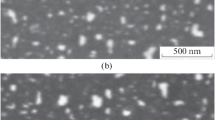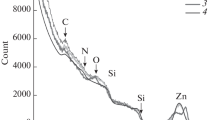Abstract
Computer simulations based on the Monte Carlo method are used to analyze processes leading to the formation of luminescence centers in SiO2 implanted with Si ions. The simulations, which take place in a two-dimensional space, mimic the growth of silicon nanoprecipitates in layers containing several at.% of excess silicon. It is assumed that percolation clusters made up of neighboring Si atoms form first. As the annealing temperature increases, these clusters grow and compactify into nano-sized inclusions of a well-defined phase. It is shown that a dose dependence arises from an abrupt enhancement of the probability of forming direct Si-Si bonds when the concentration of silicon exceeds ∼1 at. %. Under these conditions, percolation chains and clusters form even before annealing begins. The effect of the temperature of subsequent anneals up to 900 °C is modeled via the well-known temperature dependence of Si diffusion in SiO2. It is assumed that annealing at moderate temperatures increases the mobility of Si atoms, thereby facilitating percolation and development of clusters due to an increase in the interaction radius. Intrinsic diffusion processes that occur at high temperatures transform branching clusters into nanoprecipitates with well-defined phase boundaries. The dose and temperature intervals for the formation of precipitates obtained from these simulations are in agreement with the experimental intervals of dose and temperatures corresponding to the appearance of and changes in luminescence.
Similar content being viewed by others
References
H. A. Atwater, K. V. Shcheglov, S. S. Wong, K. J. Vahala, R. S. Flagan, M. I. Brongersma, and A. Polman, Mater. Res. Soc. Symp. Proc. 321, 363 (1994).
T. Shimizu-Iwayama, S. Nakao, and K. Saitoh, Appl. Phys. Lett. 65, 1814 (1994).
P. Mutti, G. Ghislotti, S. Bertoni, J. Bonoldi, G. F. Cerofolini, J. Meda, E. Grilli, and M. Guzzi, Appl. Phys. Lett. 66, 851 (1995).
T. Shimizu-Iwayama, Y. Terao, A. Kamiya, M. Takeda, S. Nakao, and K. Saitoh, Nucl. Instrum. Methods Phys. Res. B 112, 214 (1996).
G. A. Kachurin, I. E. Tyschenko, K. S. Zhuravlev, N. A. Pazdnikov, V. A. Volodin, A. K. Gutakovsky, A. F. Leier, W. Skorupa, and R. A. Yankov, Nucl. Instrum. Methods Phys. Res. B 112, 571 (1997).
G. A. Kachurin, K. S. Zhuravlev, N. A. Pazdnikov, A. F. Leier, I. E. Tyschenko, V. A. Volodin, W. Skorupa, and R. A. Yankov, Nucl. Instrum. Methods Phys. Res. B 127/128, 583 (1997).
W. Skorupa, R. A. Yankov, I. E. Tyschenko, H. Frob, T. Bohme, and K. Leo, Appl. Phys. Lett. 68, 2410 (1996).
W. Skorupa, R. A. Yankov, L. Rebohle, H. Frob, T. Bohme, K. Leo, I. E. Tyschenko, and G. A. Kachurin, Nucl. Instrum. Methods Phys. Res. B 119, 106 (1996).
G. A. Kachurin, I. E. Tyschenko, W. Skorupa, R. A. Yankov, K. S. Zhuravlev, N. A. Pazdnikov, V. A. Volodin, A. K. Gutakovskii, and A. F. Leier, Fiz. Tekh. Poluprovodn. 31, 730 (1997) [Semiconductors 31, 626 (1997)].
I. E. Tyschenko, G. A. Kachurin, K. S. Zhuravlev, N. A. Pazdnikov, V. A. Volodin, A. K. Gutakovsky, A. F. Leier, H. Frob, K. Leo, T. Bohme, L. Rebohle, R. A. Yankov, and W. Skorupa, Mater. Res. Soc. Symp. Proceedings 438, 453 (1997).
G. Ghislotti, B. Nielsen, P. Asoka-Kumar, K. G. Lynn, A. Gumbhir, L. F. Di Mauro, and C. E. Bottani, J. Appl. Phys. 79, 8660 (1996).
L.-S. Liao, X.-M. Bao, N.-S. Li, X.-Q. Zheng, and N.-B. Min, J. Lumin. 68, 199 (1996).
G. A. Kachurin, L. Rebohle, I. Skorupa, R. A. Yankov, I. E. Tyschenko, H. Frob, T. Bohme, and L. Leo, Fiz. Tekh. Poluprovodn. 32, 439 (1998) [Semiconductors 32, 395 (1998)].
L. A. Nesbit, Appl. Phys. Lett. 46, 38 (1985).
J. Maeda, Phys. Rev. B 51, 1658 (1995).
A. Hartstein, J. C. Tsang, D. J. Di Maria, and D. W. Dong, Appl. Phys. Lett. 36, 836 (1980).
F. S. Ham, J. Appl. Phys. 30, 1518 (1959).
I. M. Lifshits and V. V. Slezov, Zh.Éksp. Teor. Fiz. 35, 479 (1958) [Sov. Phys. JETP 8, 331 (1958)].
A. B. Pevtsov, V. Ju. Davydov, N. A. Feoktistov, and V. G. Karpov, Phys. Rev. B 52, 955 (1995).
Author information
Authors and Affiliations
Additional information
Fiz. Tekh. Poluprovodn. 33, 389–394 (April 1999)
Rights and permissions
About this article
Cite this article
Leier, A.F., Safronov, L.N. & Kachurin, G.A. Modeling Si nanoprecipitate formation in SiO2 layers with excess Si atoms. Semiconductors 33, 380–384 (1999). https://doi.org/10.1134/1.1187698
Received:
Accepted:
Issue Date:
DOI: https://doi.org/10.1134/1.1187698




